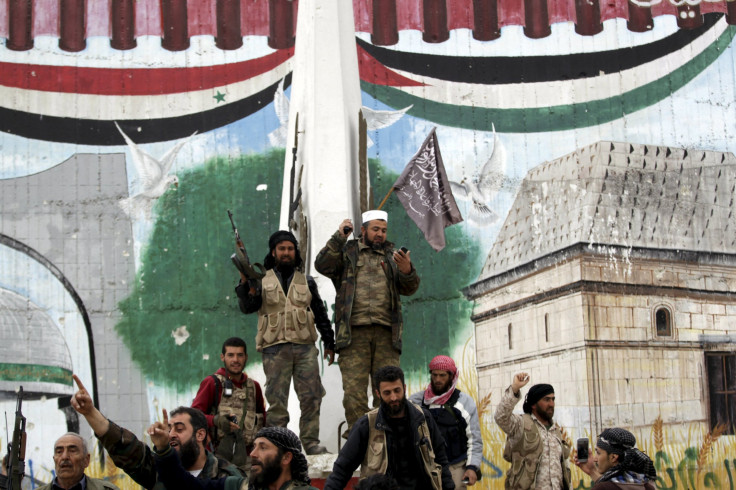Jabhat Al-Nusra And ISIS Alliance Could Spread Beyond Damascus

ISTANBUL -- Jabhat al-Nusra, the Syrian offshoot of the terrorist organization al Qaeda, has been joining ranks in some parts of Syria with rebel groups that were once the country’s main recipients of U.S. weapons. The two sides are banding together in key areas, including the outskirts of the capital Damascus and northern Aleppo, Syria’s biggest city, rebels fighting in Aleppo told International Business Times. That coordination has given the opposition more military might in the fight against President Bashar Assad, but is also sending a worrying message back to the Obama administration: The weapons it once provided to Syrian rebels may now end up in the hands of the very extremists it wants to quash, such as the Islamic State group.
Washington now has to worry not only about American weapons getting into the hands of al Qaeda-linked groups but also about them reaching the Islamic State group. According to Syrian fighters, Jabhat al-Nusra, aka the Nusra Front, is working alongside the militant group formerly known as ISIL or ISIS in the Yarmouk refugee camp outside Damascus to defeat the Assad regime’s military and local Palestinian factions. Some reports have hinted the Nusra Front may have even pledged allegiance to the Islamic State group in Yarmouk.
If the collaboration between the Nusra Front and the Islamic State group in Yarmouk, close to downtown Damascus, becomes a model followed in other parts of Syria, the opposition to Assad will consist almost exclusively of ultraradical Islamists. The U.S. will be left without any credible faction to back in the fight against the regime, and its top enemy in the region, the Islamic State group, will be strengthened.
Northern Syria -- where the Free Syrian Army and the military were until recently the only factions fighting -- has turned into a cauldron of opposition groups vying for power. The last moderate rebel group in the north, Harakat Hazm, dissolved last month, nullifying the two-year-old American campaign to prop it up with weapon deliveries.
The Obama administration approved a CIA-led program in the spring of 2013 that delivered support to those then considered moderate rebels, all of whom fought under the umbrella known as the Free Syrian Army, the main opposition group fighting Assad after the Syrian Civil War began in 2011. The CIA program allowed for the transfer of U.S.-made weapons via Turkey, and it was partially funded by Saudi Arabia and other wealthy Sunni states. But the rebel groups that were the beneficiaries of that aid began to dissolve when better-financed and -organized militias, such as the Islamic State group and the Nusra Front, emerged.
The rebels that received U.S. aid joined other, stronger groups, bringing their weapons with them. In December, a video surfaced of a ceremony honoring the unification of some rebel entities in a group now called the Al Shamia Front -- with which the Nusra Front promptly aligned itself, at least on the battlefield.
But in the north of Syria, at least, this new group and the Islamic State group have not forged an alliance.
“There is military coordination between al-Nusra and the Al Shamia Front on the ground in fighting both the regime and the Islamic State,” said Oussama Abu Zayd, one of the advisers to the Al Shamia Front. “Most of the factions within the Al Shamia Front have had previous military coordination with Jabhat al-Nusra.”
Ward Furati, the media director of the Al Shamia Front, said rebels in Al Shamia make up 80 percent of all rebels in Aleppo. He said the Nusra Front and Al Shamia are collaborating only on the battlefield and do not align ideologically.
Despite these ideological differences, the collaboration between the Nusra Front and other rebels has already yielded a relevant victory: the recapture of Idlib from the Assad regime.
There, the Nusra Front and other rebels created a coordinated force known as Jaysh al-Fatah, meaning the Army of Conquest, which included Ahrar al-Sham, an ultraconservative group, and other Islamist organizations within the Al Shamia Front. After weeks of fighting and constant aerial bombardments by Assad’s air force, the rebels pushed the military out of the city and claimed control. It was the first major win for the opposition since it lost Homs to the military last year, but it came only because of ultraconservative Islamist fighters.
The Idlib victory “represents a turning point in the Syrian Civil War that is likely to alter the trajectory of the conflict in coming months, with implications for how rebels wage war in 2015,” the Institute for the Study of War said in a recent report. Idlib was “much of more of a victory for al Qaeda in Syria than a victory for the Syrian revolution,” said the public-policy think tank based in Washington. On the ground, residents have said they fear a city run by the extremist group would be as bad as living under the Islamic State group.
Battles such as the one in Idlib “will likely provide momentum to the JN-Islamist axis in Syria at the expense of moderate rebel forces, and hinder efforts to foster a political solution to the conflict,” the Institute for the Study of War said.
Defections from the increasingly small moderate rebel movement will make it more difficult for the U.S. to oust Assad by backing fighters who are associated with neither al Qaeda nor the Islamic State group. The current strategy is to find fighters who can be vetted and trusted, then trained and given weapons. The U.S. Defense Department told IBTimes via email it had “identified approximately 2,200 personnel by name” that it could train and equip with arms. But, as the war enters its fifth year, that process has yet to begin.
© Copyright IBTimes 2025. All rights reserved.





















